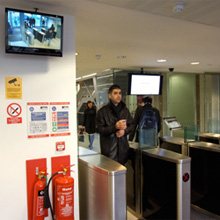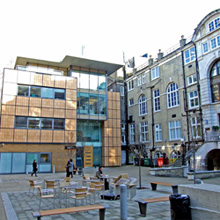With a history spanning over 180 years, University College London (UCL), is one of the oldest and most well known seats of learning in the UK. Secured with a CCTV system comparable in size to most town center installations, UCL's security management are now reaping the numerous cost and performance benefits of a NVT UTP Hybrid Video transmission solution, designed to cater for ever-expanding camera numbers.
Today, UCL continues to be London's leading multidisciplinary university, with 8,000 staff and 22,000 students, from over 150 countries, and is proud to be a true global university and research center of world-renown. With a central campus located on Gower Street in the Bloomsbury area of London, the university continues to expand within new buildings located throughout the area.
UCL's mix of faculties, spread over an openly accessible campus area, has provided the university's management with quite a challenge to meet the requirement for an effective security surveillance solution. A primary CCTV system, consisting of 25 external cameras, was installed eleven years ago, covering the main pedestrian and vehicular routes on campus.
Growing through the years via a series of expansions, 2003 saw the disparate elements of the CCTV network consolidated into a more focused structure. Paul Hayden, Control Room Manager at UCL explains: "By this time we had quite a large system connected via an ageing and complicated coax cable network. At that time, we wanted to add a number of cameras and relocate the control room, so it seemed an ideal point to re-evaluate the system's direction. With technical input from our onsite contractor, Trio Security Systems Ltd we redesigned the system from the ground up. Taking into account the long-term needs and tight budget constraints of both our new and existing camera network, we established that our needs would be best served through the installation of an NVT UTP video transmission system."
UTP vs. coax
Andy Halcro, Director of Trio Security Systems explains: "Introducing the use of NVT UTP video transmission meant the university would no longer be tied to the existing coax network that had become cumbersome, as well as difficult and costly to expand, particularly in view of the kind of additional camera numbers they required.
"The university consists of several, historically important buildings, some of which date from the beginning of its 180-year history. Using NVT UTP meant we could harness the video transmission potential of the university's Twisted Pair cable infrastructure, already installed as part of its internal telephone network, but not fully utilised. This comprehensive network, which connects all of the university's buildings, is contained in underground ducting alongside other building infrastructure, such as power and data communication services. Capitalising on NVT's inherent interference rejection capabilities allowed direct connection to this network, with no interference issues from other services being experienced whatsoever.
"During the relocation of the control room, it was important that images from each live camera incurred minimal downtime. Using NVT transmission we were able to patch images across to the new UTP network utilising NVT's rack-mounted receivers, keeping images streaming into the old control room, before we simply unplugged the relevant connection and reconnected it into the new control room facility. This afforded a seamless transition between the two, and meant the university didn't lose any camera footage throughout the system change-over period."
Superior video
 |
| LCD monitors show live high quality camera footage at the entranceways of UCL's main buildings |
Paul Hayden adds: "The process of unplugging the coax cables and instantly replacing it with NVT UTP transmission from the same camera really highlighted the difference in image quality between the two transmission methods. The NVT UTP images were noticeably sharper and a clear improvement over the previous coax based pictures."
Using NVT technology to transmit video on a Twisted Pair cable infrastructure that already existed at the site also meant ideal scene coverage could be achieved for each camera, by affording exact camera placement within these historical surroundings, Paul Hayden explains: "By utilising compact and flexible UTP cable runs, versus the burden of cumbersome coax bundles, we were able to mount cameras in the best possible locations, even within the 180 years old buildings, where disturbing historical fixtures and fittings was just not an option!"
Hybrid analog-IP solution
"Images from each camera are transmitted to multiple NVT NV-862, NV-1662, and NV-3262 Active UTP video receiver hubs located in a purpose-built equipment room, adjacent to the new control room." Andy Halcro continues: "For the CCTV system's control and recording we made the decision at the start of the project to use a Pelco IP-based control system, but wanted to avoid the use of a total IP infrastructure and its associated limitations, such as equipment cost and control latency. This is where using NVT's UTP technology to provide a Hybrid Video solution gave us the benefits of both worlds, with none of the drawbacks, obviating the need for expensive and comparatively poor performing IP cameras, along with the latency control issues associated with an end-to-end IP network. The high-quality analog camera images received in the adjacent equipment room are now encoded and transmitted via a dedicated IP network, to the control room next door, where a team of two operators control and monitor the images via a video wall and spot monitors. Recording is provided by multiple DVRs, again located in the equipment room.
"The system now covers all aspects of the university's buildings, many of which are Pelco domes supplied with NVT connectivity already built-in, making them very quick and easy to integrate. In addition, we now have a scaleable system, affording the ability to connect additional cameras in existing buildings to the ‘spare' UTP pairs installed. Being involved from the start with any new building works means we can specify dedicated UTP networks to be installed at the time of build. This kind of expert involvement right from the start of the project enables UCL to minimize the cost, whilst maximising the performance and flexibility of operation."
Visual benefits
Working in conjunction with access control and a comprehensive manned guarding team, the new CCTV system is used to protect students, staff and university facilities 24 hours a day. From the security control room, operators can access images from all campus exteriors and interiors, such as main entrances/exits, corridors, and refectory and leisure areas. "Thanks to the clarity of the NVT UTP video transmission based camera images, we can readily identify individuals from video footage, or forward prosecutional quality images if required, to the Police for further investigation." continues Paul Hayden: "The system is primarily designed to keep unauthorized people from entering the various campuses and buildings. As well as the safety of our staff, we have expensive equipment in many of the faculties, which could be targeted by thieves, so the extra ‘eyes' of the camera network are invaluable in assisting our security team, and give us an unparalleled overview of any areas of the site.
 |
| The new CCTV system provides 24/7 surveillance and operators can access images from all areas around campus |
"During the expansion of the surveillance system, both criminal and anti-social instances were reduced dramatically the moment new cameras were introduced, an effect that was particularly evident at the number of bicycle storage areas across all campuses. We believe this effect is greatly enhanced if the presence of the cameras is promoted effectively. That's why in addition to CCTV signage, we employ large LCD displays in the entranceways of main buildings. These show live camera coverage of the immediate vicinity and are a great way of reinforcing the quality of images we have available from the system. They also for example, provide a measure of reassurance for female staff leaving the building late at night, as they can check the surrounding area outside the building before they leave.
"We also use the system to track vehicular movements around the campuses. With space being limited and having to manage quite a number of deliveries most days, it is important that we manage the onsite traffic movement in the most effective way. The system has also proved a great health and safety management tool in other instances too, such as within the clean environment rooms of our Nano Technology building, where the adherence to Health and Safety protocols is critical."
The latest expansion to the system has included UTP video transmission runs of over 900 metres and uses the latest NVT Digital EQ hubs, sourced from Norbain. Andy Halcro enthuses: "The continuous self adjustment of the Digital EQ Hubs means as well as fast installation, any variation in video signal content is automatically compensated for. For instance, if university telecom engineers replace a section of old UTP cable across the university network, this can alter the signal received by the hub in the communication room, but with NVT's Digital EQ hubs, this is automatically compensated for, with no intervention being required by us, in the long term saving time and money on service call outs."
As University College London continues to expand on, and improve its network of buildings, the NVT UTP Hybrid Video transmission solution will continue to provide the key to a high performance, cost effective and flexible future-proofed electronic surveillance network.









